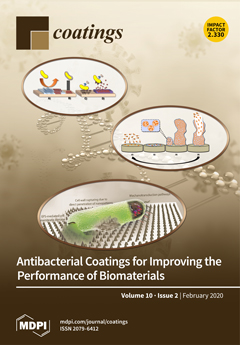Herein, we report the fabrication of a modified glassy carbon electrode (GCE) with high-performance hydrazine sensor based on Fe-doped TiO
2 nanoparticles prepared via a facile and low-cost hydrothermal method. The structural morphology, crystalline, crystallite size, vibrational and scattering properties were examined through
[...] Read more.
Herein, we report the fabrication of a modified glassy carbon electrode (GCE) with high-performance hydrazine sensor based on Fe-doped TiO
2 nanoparticles prepared via a facile and low-cost hydrothermal method. The structural morphology, crystalline, crystallite size, vibrational and scattering properties were examined through different characterization techniques, including FESEM, XRD, FTIR, UV–Vis, Raman and photoluminescence spectroscopy. FESEM analysis revealed the high-density synthesis of Fe-doped TiO
2 nanoparticles with the average diameter of 25 ± 5 nm. The average crystallite size of the synthesized nanoparticles was found to be around 14 nm. As-fabricated hydrazine chemical sensors exhibited 1.44 μA µM
−1 cm
−2 and 0.236 µM sensitivity and limit of detection (LOD), respectively. Linear dynamic ranged from 0.2 to 30 µM concentrations. Furthermore, the Fe-doped TiO
2 modified GCE showed a negligible inference behavior towards ascorbic acid, uric acid, glucose, SO
42−, NO
3−, Pb
2+ and Ca
2+ ions on the hydrazine sensing performance. Thus, Fe-doped TiO
2 modified GCE can be efficiently used as an economical, easy to fabricate and selective sensing of hydrazine and its derivatives.
Full article





